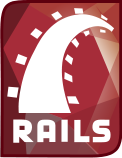Ruby on Rails
 | |
| Original author(s) | David Heinemeier Hansson |
|---|---|
| Developer(s) | Rails core team |
| Initial release | December 13, 2005[1] |
| Stable release |
7.1.3.4 (June 4, 2024) [±] |
| Preview release | 6.0.0 RC1 (April 24, 2019) [±] |
| Written in | Ruby |
| Operating system | Cross-platform |
| Type |
Software development tool Web application framework |
| License(s) | MIT License |
| Website | RubyOnRails.org |
Ruby on Rails, often shortened to Rails or RoR, is an open-source full-stack web application framework for the Ruby programming language. Ruby on Rails is not to be confused with Ruby, which is a general-purpose programming language, on which Ruby on Rails runs. Ruby itself existed for more than 10 years before the first release of Ruby on Rails.
Rails is a full-stack framework, meaning that it gives the Web developer the full ability to gather information from the web server, talk to/query the database, and render templates out of the box. As a result, Rails features a routing system that is independent of the Web server.
Product history
David Heinemeier Hansson extracted Ruby on Rails from his work on Basecamp, a project management tool by 37signals (now a web application company).[2] Hansson first released Rails as open source in July 2004, but did not share commit rights to the project until February 2005.[3] In August 2006, the framework reached a milestone when Apple announced that it would ship Ruby on Rails with Mac OS X v10.5 "Leopard,"[4] which was released in October 2007.
Rails version 2.3 was released on March 15, 2009. Major new developments in Rails included templates, engines, Rack support, and nested model forms. Templates suddenly allowed the developer to generate a skeleton application with custom RubyGems and configurations. Engines allowed for the reuse of application pieces complete with routes, view paths, and models. The Rack web server interface and Metal enabled users to write optimized pieces of code that route around ActionController.[5]
On December 23, 2008, Merb, another web application framework, was launched, and Ruby on Rails announced it would work with the Merb project to bring "the best ideas of Merb" into Rails 3, ending the "unnecessary duplication" across both communities.[6] Merb was merged with Rails as part of the Rails 3.0 release.[7]
Rails 3.1 was released on August 31, 2011, featuring reversible database migrations and the asset pipeline.
Features
Features of Ruby on Rails include:
- Model/View/Controller architecture
- database access library
- libraries for common tasks
- AJAX Library
- convention over configuration
- customized URL
- debugging
- components and templates
- jQuery support
- HTML and XML output
Hardware/software requirements
The installation requirements for Ruby on Rails are[8]:
- the Ruby language version 1.8.7 or higher (excluding 1.9.1)
- the RubyGems packaging system
- a functioning installation of a SQLite3 database
Videos, screenshots, and other media
A wide array of tutorial videos for Ruby on Rails can be found on the website.
Entities using Ruby on Rails
Further reading
- "Ruby on Rails Documentation". RubyOnRails.org. http://rubyonrails.org/documentation.
External links
- RubyForge.org
- Railscasts.com
- Ruby on Rails at GitHub
References
- ↑ Hansson, David Heinemeier (13 December 2005). "Rails 1.0: Party like it's one oh oh!". RubyOnRails.org. http://weblog.rubyonrails.org/2005/12/13/rails-1-0-party-like-its-one-oh-oh/. Retrieved 22 March 2012.
- ↑ Grimmer, Lenz (February 2006). "Interview with David Heinemeier Hansson from Ruby on Rails". Oracle Corporation. http://dev.mysql.com/tech-resources/interviews/david-heinemeier-hansson-rails.html. Retrieved 22 March 2012.
- ↑ "The core team". RubyOnRails.org. http://rubyonrails.org/core. Retrieved 22 March 2012.
- ↑ Hansson, David Heinemeier (7 August 2006). "Ruby on Rails will ship with OS X 10.5 (Leopard)". RubyOnRails.org. http://weblog.rubyonrails.org/2006/8/7/ruby-on-rails-will-ship-with-os-x-10-5-leopard. Retrieved 22 March 2012.
- ↑ Hansson, David Heinemeier (16 March 2009). "Rails 2.3: Templates, Engines, Rack, Metal, much more!". RubyOnRails.org. http://weblog.rubyonrails.org/2009/3/16/rails-2-3-templates-engines-rack-metal-much-more. Retrieved 22 March 2012.
- ↑ "The day Merb joined Rails". RubyOnRails.org. http://rubyonrails.com/merb. Retrieved 22 March 2012.
- ↑ Handy, Alex (10 February 2010). "Ruby on Rails 3.0 goes modular". SD Times. http://www.sdtimes.com/link/34122. Retrieved 22 March 2012.
- ↑ "Getting Started with Rails". RubyOnRails.org. http://guides.rubyonrails.org/getting_started.html. Retrieved 22 March 2012.









